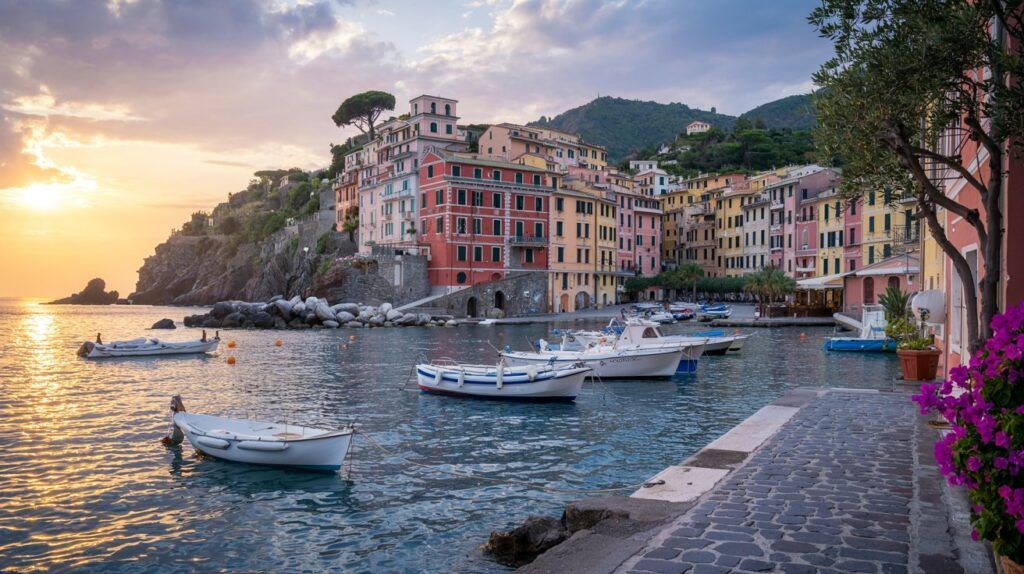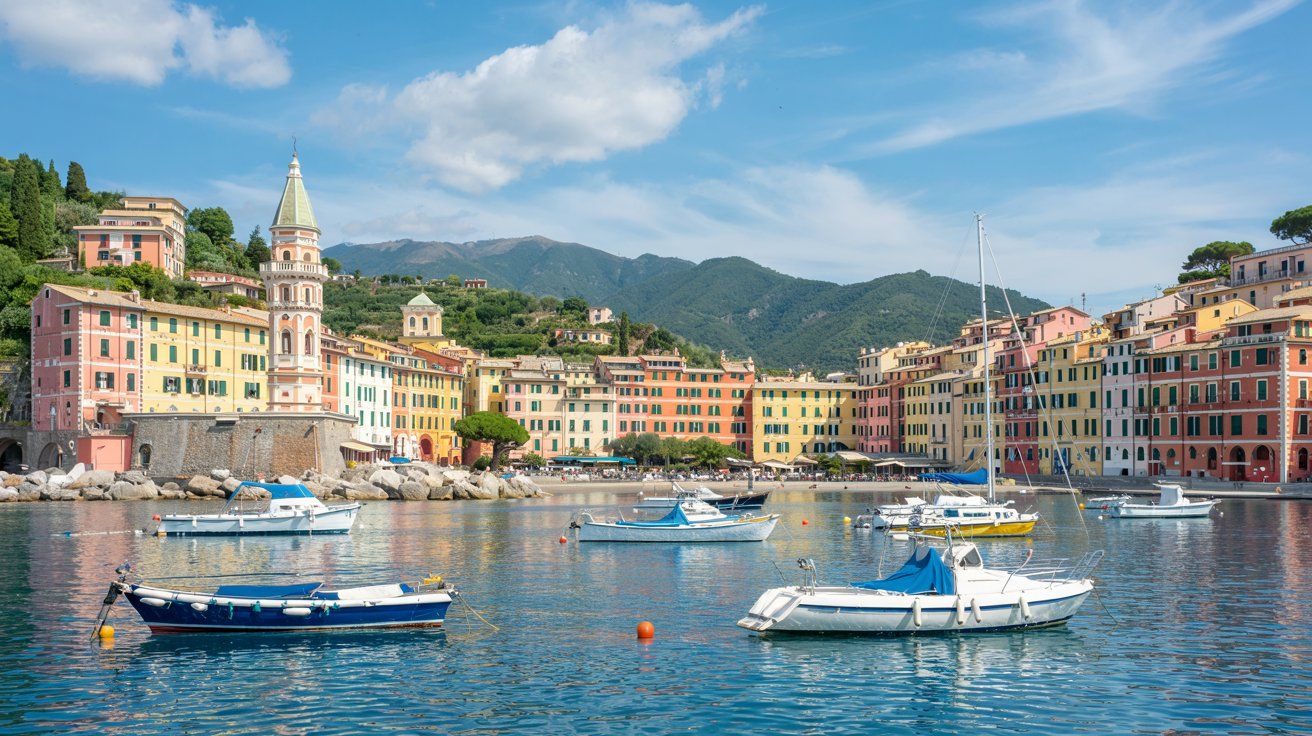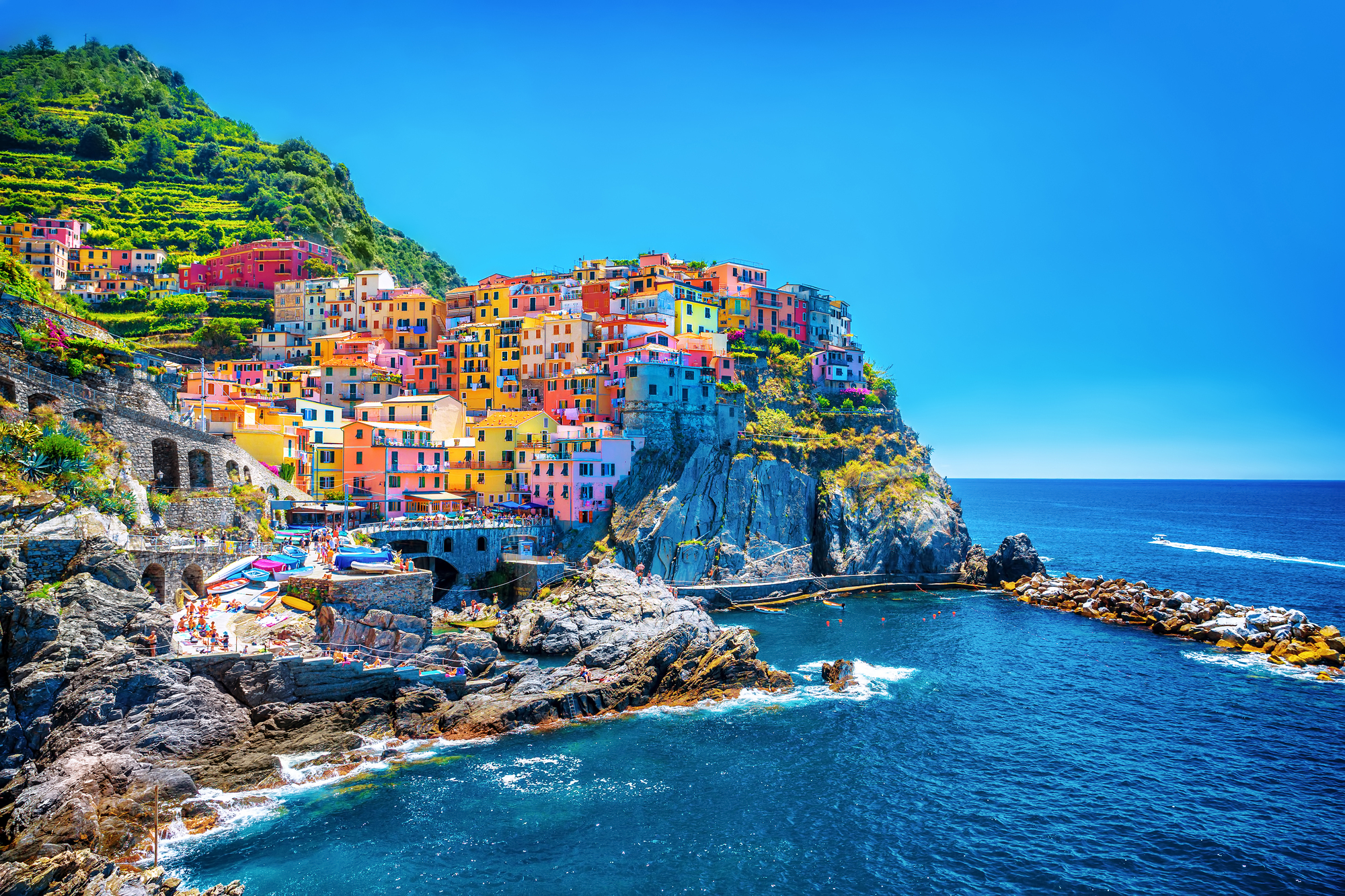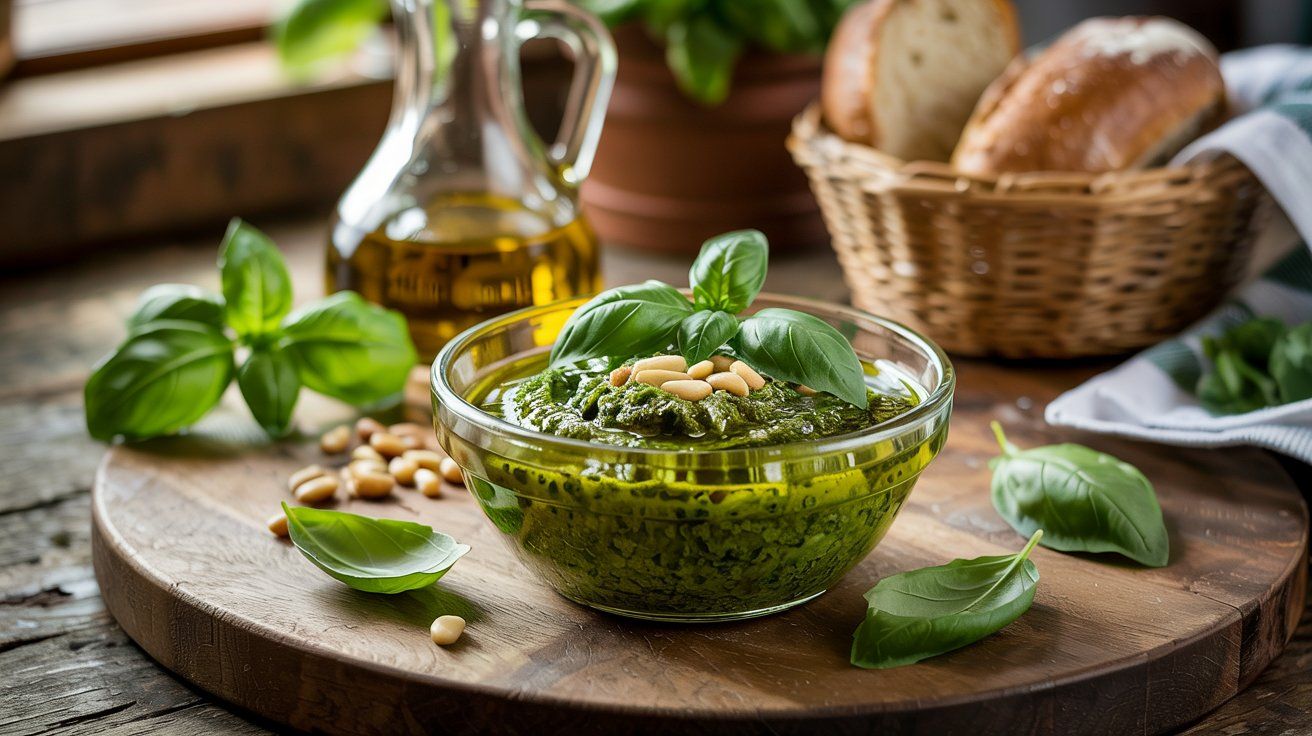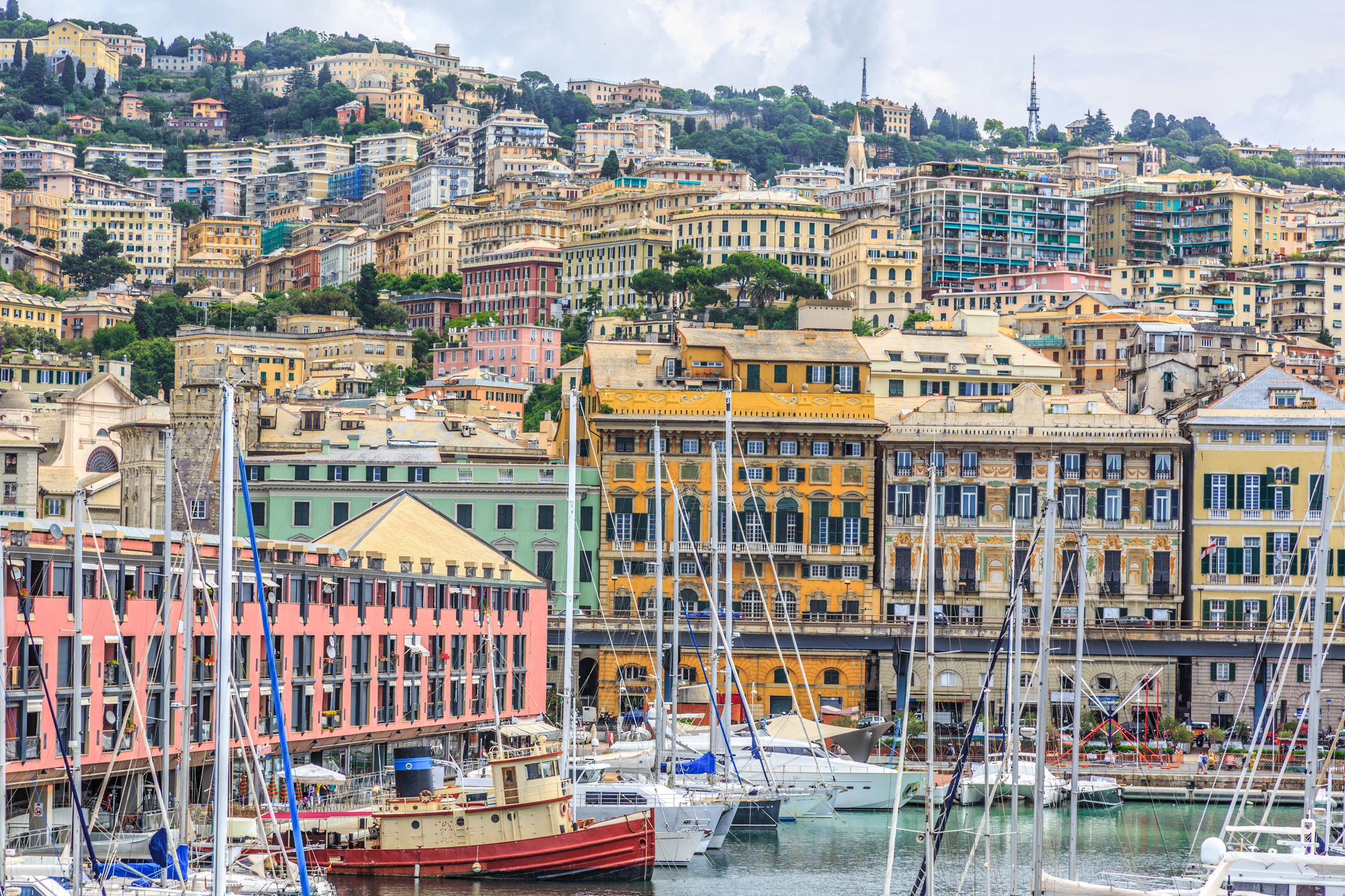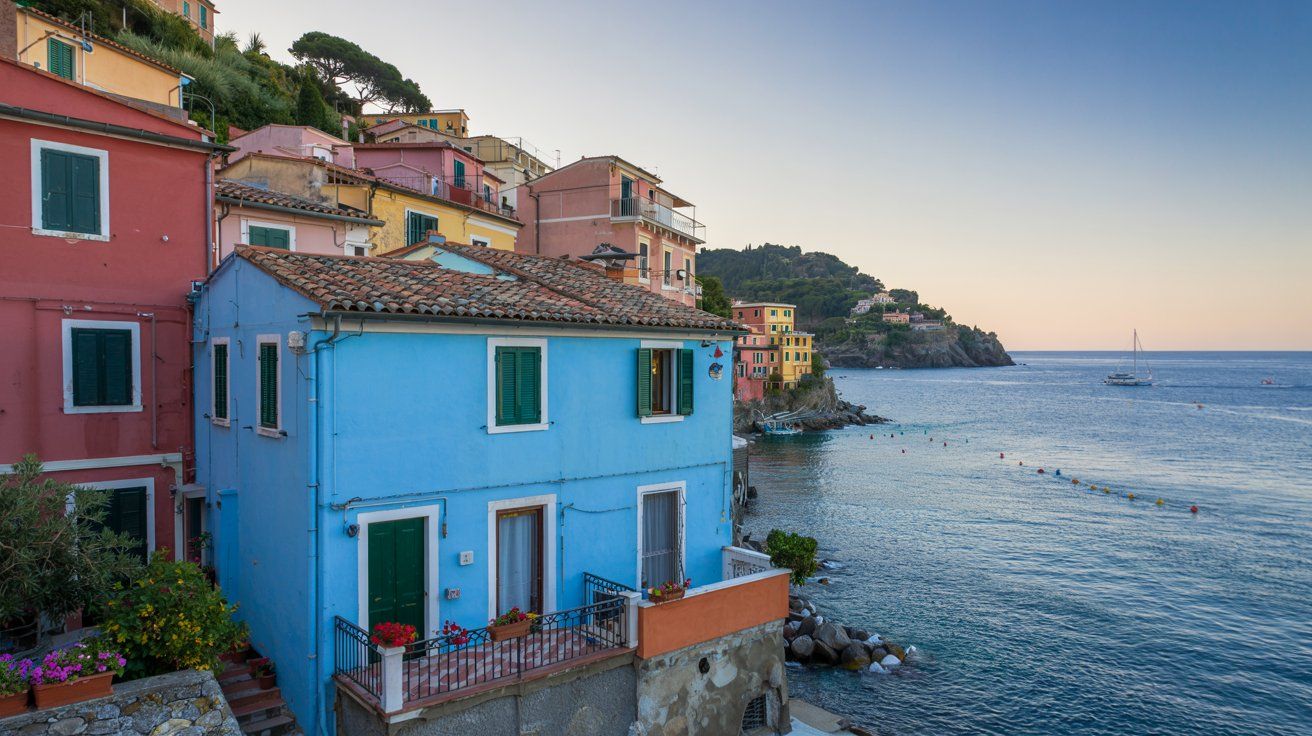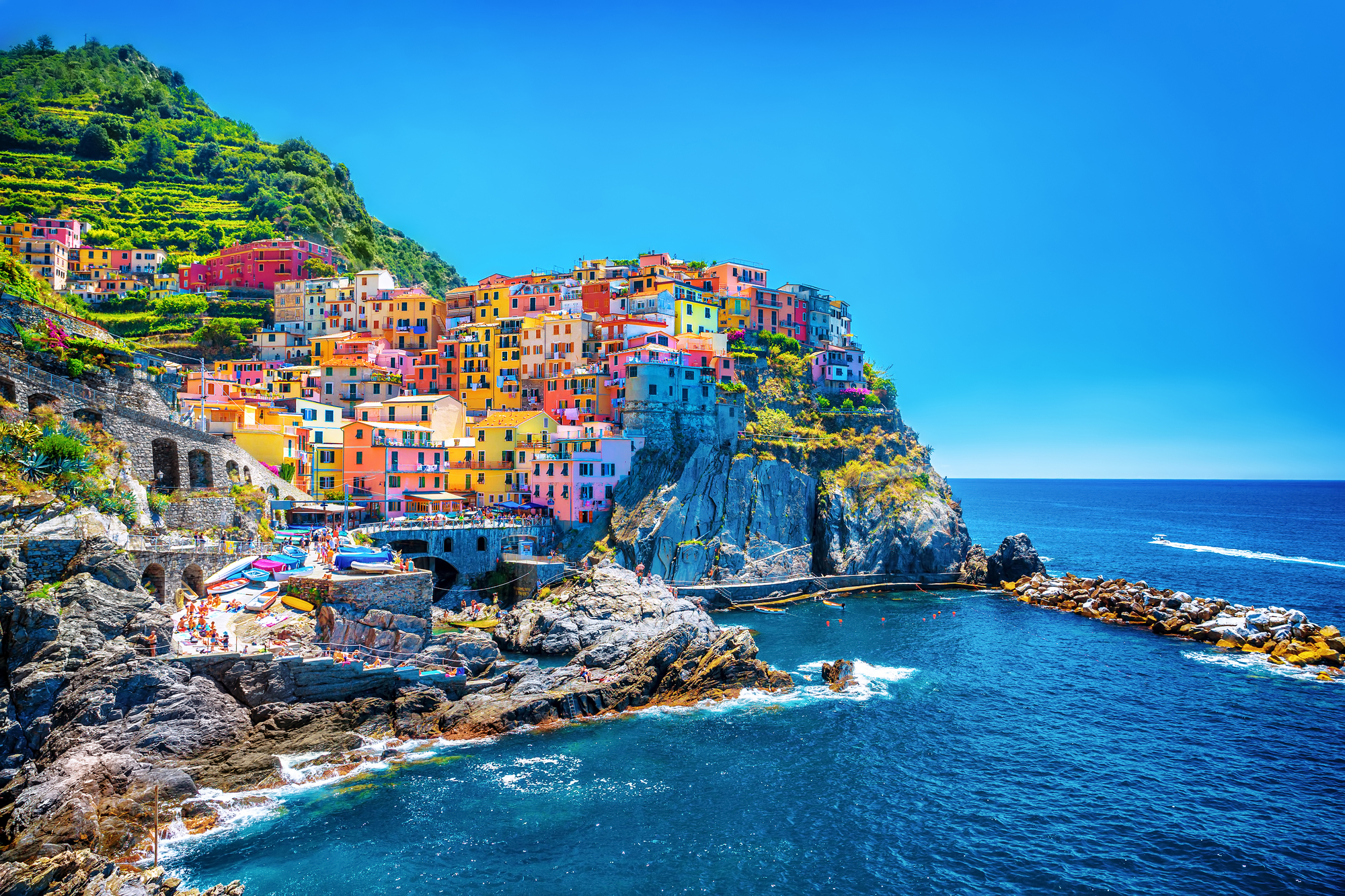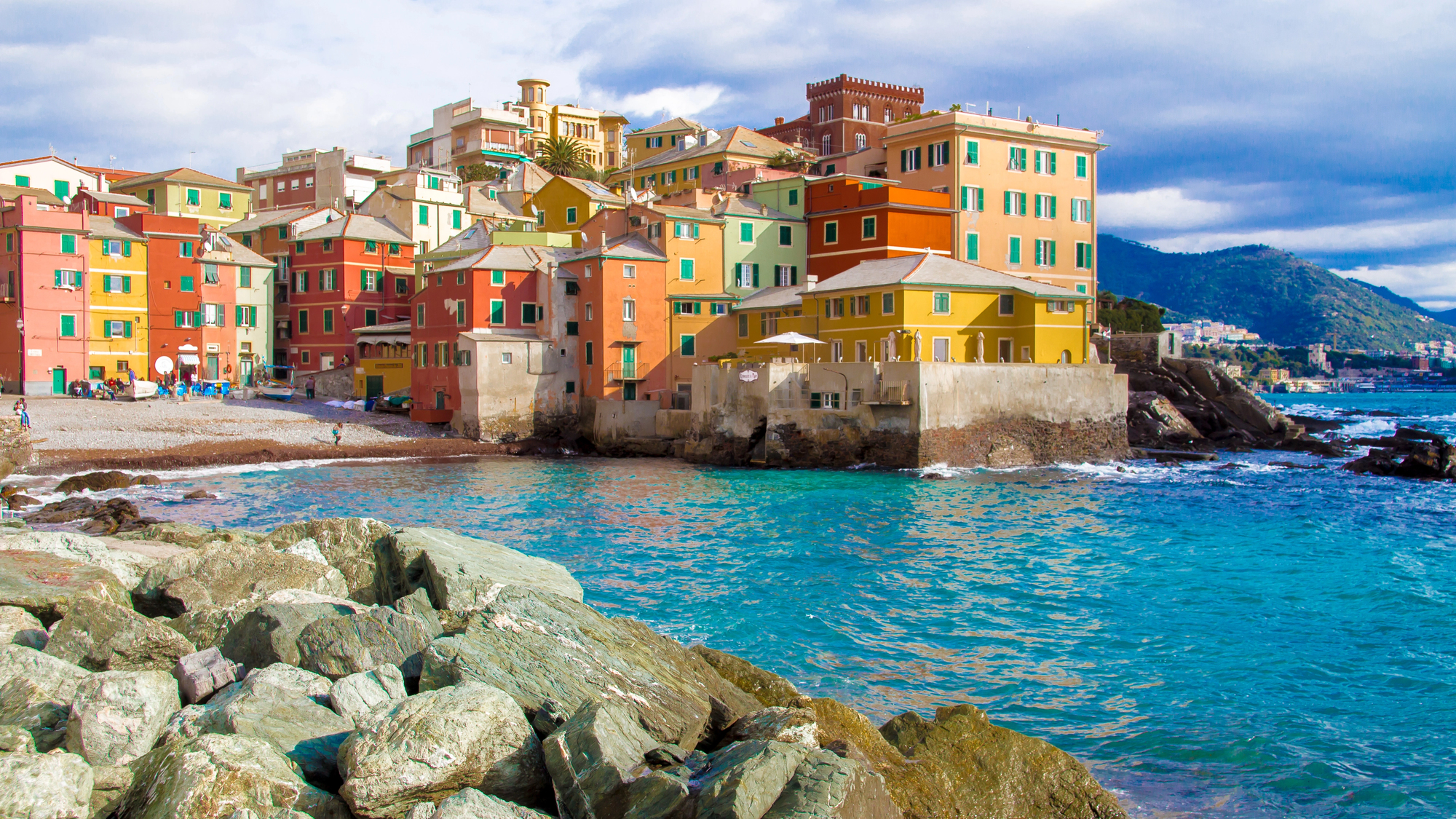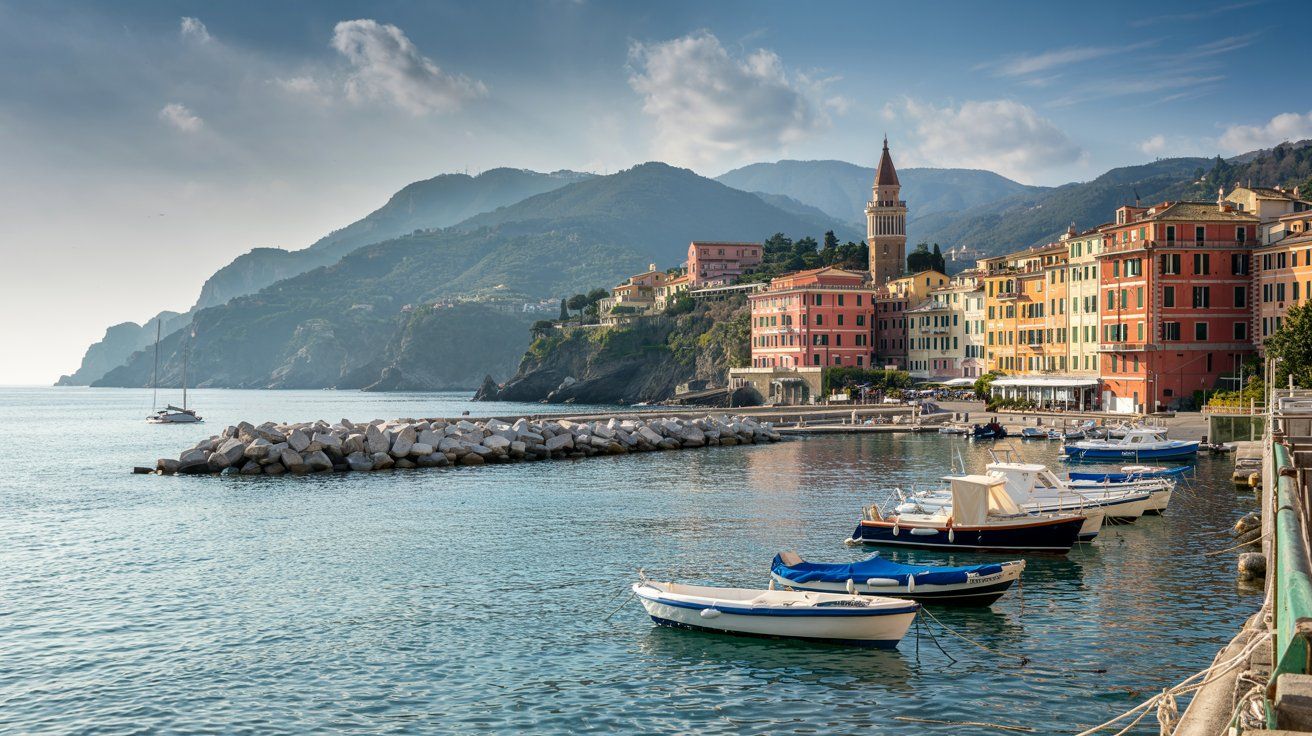Nestled in the crescent-shaped region of Liguria in northern Italy, the Italian Riviera boasts a rich history that stretches back thousands of years. This stunning coastline, extending about 350 kilometers from the French border to Tuscany, has been captivating visitors for centuries with its blend of natural beauty and human achievement. The Italian Riviera’s history is a fascinating tapestry woven from maritime power, cultural exchange, and Mediterranean trade that transformed a simple coastline into one of the world’s most beloved destinations.
The heart of the region’s story centers around Genoa, which emerged as a powerful maritime republic in 1099. As Liguria grew in influence, it rivaled even Venice for control of Mediterranean trade routes. Walking through the region today, you’ll discover remnants of this prosperous past in the colorful fishing villages, grand palaces, and ancient harbors that dot the coastline. These Italian Riviera landmarks tell stories of seafaring merchants, ambitious nobles, and ordinary people who shaped this spectacular region.
You can experience this living history when you visit the Italian Riviera today. The region’s unique cultural identity remains beautifully preserved in its architecture, cuisine, and traditions. From the medieval alleyways of Genoa to the pastel-painted houses of Cinque Terre, every corner reveals another chapter in Liguria’s remarkable journey through time. The same sea breezes that filled the sails of ancient trading vessels now carry the scents of fresh seafood and lemon groves to enchant modern travelers.
Geographical Overview
The Italian Riviera stretches along the Mediterranean Sea in northern Italy, forming a beautiful arc of coastline from the French border to Tuscany. This stunning region is part of Liguria, a crescent-shaped region nestled between the sea and mountains.
You’ll find the Italian Riviera protected by the Maritime Alps and Ligurian Apennines to the north. This natural barrier creates an exceptional microclimate with mild winters and sunny, warm summers that you’ll surely appreciate during your visit.
To the west, the Italian Riviera historically extended into what is now the French Riviera. The charming city of Nice was once part of this connected coastline before becoming French territory.
The dazzling blue waters of the Ligurian Sea wash against the rocky shores and hidden coves of this magnificent coastline. The sea here is particularly clear, making it perfect for swimming and water activities.
As you travel east along the coast, you’ll eventually reach Tuscany, where the landscape begins to change. The Italian Riviera’s dramatic cliffs and compact fishing villages give way to Tuscany’s gentler shores.
The geography of the Italian Riviera has shaped its history and culture. With limited flat land between mountains and sea, colorful villages cling to hillsides or nestle in small coves, creating the postcard-perfect scenes that make this region so irresistible to travelers.
Ancient History and Origins
The origins of the Italian Riviera date back thousands of years to the Neolithic period. Archaeological evidence shows the first inhabitants of this stunning coastline were the Ligurians, a pre-Indo-European people who gave their name to the entire region.
When you visit the Italian Riviera today, you’re walking in the footsteps of these ancient peoples who settled along this narrow coastal strip between the Ligurian Sea and the mountain chain. The Ligurians built settlements throughout what would later become the provinces of Genoa, Savona, Imperia, and La Spezia.
In Ventimiglia, near the French border, you can explore fascinating remnants of these early civilizations. This border town serves as a gateway to understanding the region’s ancient past.
By the 1st century BC, the Roman Empire had set its sights on this strategic coastline. The Romans recognized the value of controlling this important Mediterranean passage and gradually brought the entire Ligurian territory under their domination.
The Romans transformed the region, building roads, ports, and settlements that would eventually develop into the charming towns you can explore today. Their influence is still visible in the architecture and layout of many coastal communities.
As you wander through Genoa’s historic center, you’re experiencing a city whose origins stretch back to these ancient times. The capital of Liguria emerged as an important Roman port, setting the foundation for its later prominence as a maritime power.
The Rise of Maritime Genoa
Genoa transformed from a small Roman naval base into one of Europe’s most dominant maritime powers, controlling trade routes throughout the Mediterranean and beyond. Its strategic location on the Ligurian Sea provided perfect access to maritime commerce.
Economic and Naval Power
Genoa’s rise began in earnest during the 11th century when the city established itself as a naval powerhouse. You’ll be amazed to learn that Genoese ships controlled much of the Mediterranean trade routes, challenging even Venice for supremacy. The city’s merchants became extraordinarily wealthy by trading silk, spices, and other valuable goods.
Their naval expertise wasn’t just for commerce. Genoa built impressive warships that protected their interests across the Ligurian Sea. The shipyards of Genoa produced vessels that were among the most advanced of their time.
The Genoese established trading posts across the Mediterranean and Black Sea, creating a vast commercial network. This web of commerce brought incredible wealth flowing back to the Italian Riviera.
Genoese Republic
The Republic of Genoa officially formed in 1099 and would remain a powerful independent state until 1797. During this time, you could have witnessed Genoa at the height of its influence, with magnificent palaces and bustling ports reflecting its prosperity.
The republic was governed by a complex system led by elected officials, with power often concentrated among wealthy merchant families. These families competed fiercely for control while funding Genoa’s expansion.
By the 1400s, Genoa had established control over the entire Ligurian region. The republic’s power extended well beyond Italy, with colonies and trading posts throughout the Mediterranean and Black Sea regions.
Walking through Genoa today, you can still see evidence of this golden age in the impressive architecture along the historic waterfront and old town.
Divided by the East and West
The Italian Riviera splits at Genoa, creating two distinct coastal sections with their own unique character and attractions. This natural division creates a wonderful opportunity for travelers to experience diverse landscapes and cultures within the same region.
Riviera Di Ponente
The “Riviera of the Setting Sun” stretches westward from Genoa to the French border. This sunny stretch boasts wide sandy beaches and charming seaside towns that attract beach lovers from across Europe.
San Remo stands as the jewel of the Ponente, famous for its casino, flower production, and annual music festival. When you visit, you’ll find a milder climate than the eastern Riviera, making it perfect for outdoor activities year-round.
The Ponente feels more relaxed and less crowded than its eastern counterpart. You’ll discover peaceful fishing villages where time seems to stand still. The region’s cuisine features simple yet delicious seafood dishes that showcase the bounty of the Mediterranean.
The western Riviera also offers excellent value for travelers on a budget. Accommodations and dining tend to be more affordable here while still delivering that quintessential Italian charm.
Riviera Di Levante
The “Riviera of the Rising Sun” extends eastward from Genoa to Tuscany. This dramatically beautiful coastline features rugged cliffs, hidden coves, and colorful villages that seem to tumble into the sea.
Portofino epitomizes the glamour of the Levante, with its picture-perfect harbor, luxury boutiques, and celebrity visitors. When you explore this eastern section, you’ll be captivated by the stunning scenery of the Cinque Terre, five colorful fishing villages connected by scenic hiking trails.
The Levante’s steeper terrain creates intimate beaches nestled between rocky outcrops. You’ll find yourself enchanted by the emerald waters perfect for swimming and snorkeling.
This eastern section tends to attract a more upscale crowd. Boutique hotels perch on cliffs offering breathtaking views, and restaurants serve sophisticated versions of Ligurian specialties like pesto and focaccia.
The Levante’s charm comes at a premium price, but the unforgettable beauty justifies the expense for those seeking a truly special Italian experience.
Notable Towns and Cities
The Italian Riviera is dotted with enchanting coastal settlements that capture the essence of Mediterranean beauty. Each town offers its own distinct character while sharing the region’s stunning seaside views and cultural richness.
The Charm of Cinque Terre
Cinque Terre consists of five colorful villages clinging dramatically to the rugged coastline. Monterosso al Mare, the largest of the five, boasts beautiful beaches and a vibrant atmosphere.
Vernazza, perhaps the most picturesque, features a natural harbor and medieval castle ruins. Its winding streets lead to charming piazzas where you can enjoy fresh seafood.
Corniglia sits high on a cliff, offering breathtaking panoramic views. Unlike its neighbors, it doesn’t directly touch the sea.
Manarola and Riomaggiore complete this UNESCO World Heritage site with their pastel-colored buildings cascading toward the sea. Hiking trails connect these villages, allowing you to experience the stunning coastline from different perspectives.
The villages are connected by the famous Sentiero Azzurro (Blue Path) walking trail, though some sections may be closed for maintenance.
The Elegance of Portofino
Portofino represents luxury and refined beauty on the Italian Riviera. This small fishing village transformed into a glamorous destination without losing its authentic charm.
Its picturesque harbor is lined with colorful buildings and luxury boutiques. Yachts bob in the crystal-clear waters while visitors sip espresso at harborside cafés.
For spectacular views, hike up to Castello Brown, a 16th-century fortress overlooking the entire bay. The panorama of the turquoise sea meeting the lush green hills is unforgettable.
Piazzetta, the town’s main square, serves as the heart of Portofino’s social scene. Here you’ll find excellent restaurants serving Ligurian specialties like pesto alla genovese and fresh seafood.
Despite its reputation for luxury, Portofino maintains a relaxed atmosphere. You can easily explore the entire village on foot within an hour.
The Harmony of Sestri Levante
Sestri Levante offers a perfect balance between authentic Italian life and tourist appeal. This charming town sits on a peninsula between two bays: the Bay of Silence and the Bay of Fables.
The Bay of Silence (Baia del Silenzio) lives up to its name with tranquil waters and a peaceful atmosphere. Its crescent-shaped beach is bordered by pastel-colored houses that create a postcard-perfect scene.
The Bay of Fables (Baia delle Favole) got its name from Hans Christian Andersen, who lived here for a time. This larger bay offers more amenities and water activities.
Sestri Levante’s old town features narrow caruggi (alleyways) lined with shops, restaurants, and gelaterias. The Saturday market brings locals and visitors together to browse fresh produce and local crafts.
Unlike some of its neighbors, Sestri Levante maintains a year-round population, giving you a glimpse into authentic Ligurian life.
The Beauty of Santa Margherita Ligure
Santa Margherita Ligure combines elegance with a relaxed seaside atmosphere. Palm trees line its waterfront promenade, where you can enjoy stunning views of the harbor filled with both fishing boats and luxury yachts.
The town’s architecture showcases the region’s distinctive trompe l’oeil facades. Many buildings feature painted decorations that mimic architectural details, creating a uniquely ornate appearance.
Villa Durazzo, surrounded by beautiful terraced gardens, offers a glimpse into the area’s aristocratic past. Its elegant rooms and art collections are open to visitors.
The Church of San Giacomo stands proudly in the center of town with its striped Baroque façade. Inside, you’ll find impressive artworks and ornate decorations.
Santa Margherita serves as an excellent base for exploring the Italian Riviera. Regular ferries and buses connect it to Portofino, Rapallo, and other nearby destinations.
Culinary Traditions
The Italian Riviera boasts a rich food heritage shaped by its coastal location and agricultural traditions. The region’s cooking emphasizes fresh, simple ingredients transformed into unforgettable flavors.
Ligurian Cuisine
Liguria’s cuisine is a delightful celebration of the sea and mountains. Pesto alla Genovese is the crown jewel of Ligurian cooking – a vibrant sauce made from locally grown basil, pine nuts, garlic, Parmigiano-Reggiano, and the region’s exceptional olive oil. You’ll find it served with trofie or trenette pasta throughout the Riviera.
Focaccia, believed to have originated in Liguria, appears in countless varieties. The most famous is Focaccia di Recco, a paper-thin bread filled with creamy cheese that melts in your mouth.
Seafood naturally dominates coastal menus. Try anchovies from Monterosso, prepared simply with lemon and olive oil, or incorporated into the traditional bagnun fish stew.
Olive oil from Taggiasca olives gives Ligurian dishes their distinct character – fruity and delicate without overwhelming the palate.
Renowned Restaurants
The Italian Riviera hosts restaurants that showcase these regional specialties with pride. In Portofino, Puny Restaurant serves perfectly executed Ligurian classics with a spectacular harbor view. Their handmade pansoti (rayon-shaped pasta with walnut sauce) follows recipes passed down through generations.
For seafood lovers, Ristorante Miky in Monterosso al Mare offers the freshest catch prepared with respectful simplicity. Their salt-crusted sea bass has earned well-deserved fame among travelers and locals alike.
In Genoa, don’t miss Zeffirino, operating since 1939. Their pesto is so renowned that Frank Sinatra reportedly had it shipped to America. For a more casual experience, visit the traditional friggitorie (fry shops) along the caruggi (narrow streets) where you can sample farinata, a savory chickpea pancake that’s a beloved street food.
The Impact of Wars on the Riviera
The Italian Riviera has faced significant challenges during wartime, particularly in World War II. When you visit this beautiful coastline today, you’d never guess the hardships these picturesque towns once endured.
In June 1940, the region became a battleground when Italian forces invaded France. The conflict brought military control to about 180 miles of Mediterranean coastline as German forces established their presence.
The towns of Imperia, Savona, and La Spezia transformed from peaceful coastal havens into strategic military positions. Daily life changed dramatically with strict curfews, forced evacuations, and property seizures.
Local residents faced food shortages and restricted movement. The beautiful beaches that now welcome you as a visitor were once lined with military defenses and subject to naval attacks.
The Franco-Italian theater saw stabilized front lines, with the war casting a long shadow over the sunny Riviera. What’s remarkable is how completely the region has recovered from these dark days.
Today as you wander through charming fishing villages and relax on golden beaches, it’s worth appreciating the resilience of these communities. The war monuments and fortifications that remain serve as subtle reminders of the Riviera’s challenging past.
When you visit La Spezia’s naval museum or notice old bunkers near Savona, you’re seeing echoes of this wartime history that shaped the modern Italian Riviera you’ve come to enjoy.
The Riviera in Modern Times
The Italian Riviera transformed dramatically after World War II, evolving from a playground for the elite to a beloved destination for travelers worldwide. Modern developments have balanced tourism growth with efforts to preserve the region’s natural beauty and cultural heritage.
Tourism Boom
The Italian Riviera experienced a massive tourism explosion starting in the 1950s and 1960s. Areas like the Riviera delle Palme, with its palm-lined promenades and golden beaches, became symbols of Mediterranean leisure. Once exclusive resorts opened to middle-class tourists, making the region’s charms accessible to many more visitors.
You’ll find the fishing village of Camogli has maintained its authentic character despite growing popularity. Its colorful houses and excellent seafood restaurants attract visitors seeking a more genuine experience away from more crowded spots.
Cruise ships now regularly dock in the region, bringing thousands of day-trippers to explore coastal towns. This tourism boom has created economic opportunities but also challenges for preserving local culture.
Conservation Efforts
In recent decades, local communities have worked hard to protect the Riviera’s delicate ecosystem and historic character. The creation of marine protected areas has helped preserve underwater habitats and improve water quality along the coast.
When you visit Lerici, you’ll notice careful restoration of historic buildings and limits on new development that might spoil the town’s medieval charm. This beautiful Gulf of Poets destination maintains strict building codes to preserve its distinctive character.
Many fishing villages have established sustainable tourism practices, limiting visitor numbers during peak seasons. Local initiatives promote off-season visits to reduce environmental impact while supporting year-round employment for residents.
You’ll also find renewed interest in traditional crafts and cuisine, with markets and festivals celebrating Ligurian heritage. These efforts help ensure that the authentic spirit of the Italian Riviera remains for future generations to enjoy.

